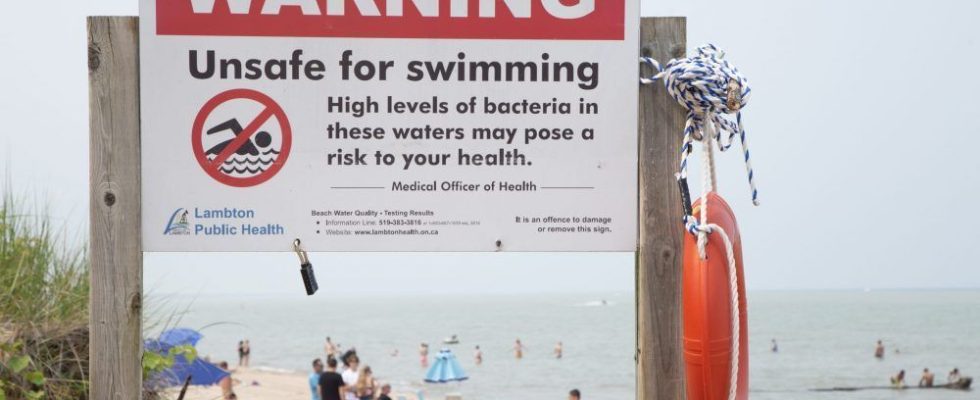Fresh off a weekend warning about E. coli at one of the area’s most popular beaches, public health officials are asking the public to be mindful of a potentially vacation-ruining germ lurking in the region’s lakes.

Fresh off a weekend warning about E. coli at one of the area’s most popular beaches, public health officials are asking the public to be mindful of a potentially vacation-ruining germ lurking in the region’s lakes. Our Jennifer Bieman has the inside track on the summertime scourge.
Escherichia coli, or E. coli for short, are bacteria that live in the bowels of healthy humans and animals such as cows, pigs and birds. E. coli enters the environment through faeces.
Many strains of the bacteria are harmless to humans, but some can cause illness, including stomach cramps, fever, diarrhea and vomiting.
Swimming in water with high levels of the bacteria can also cause ear, eye and throat infections.
While severe complications from E. coli are rare, young children and seniors have a heightened risk of developing a life-threatening form of kidney failure from an E. coli infection.
A harmful strain of the bacteria was implicated in the deaths of seven people during the 2000 drinking water crisis in Walkerton.
The feces-based bacteria can accumulate in the water in several ways, with heavy rain and resulting runoff being major culprits, said Maddy Boyko, the public health inspector overseeing the beach water sampling program at Southwestern Public Health, which oversees Elgin and Oxford counties.
Feces from birds, particularly seagulls and geese at the beach, can contribute to water contamination. Human factors, including faulty septic systems, sewage treatment plants near the shoreline and runoff from storm sewers can also sweep E. coli into the lakes.
Manure spills and field runoff from farms into rivers and streams can also introduce E. coli into area swimming holes.
Strong waves and rough water can also churn up and disperse settled E. coli contaminants in the water or shore.
“We know that we have E. coli that lives in the sediment on our beaches. So when we have high winds and heavy rain and heavy waves, it suspends that E. coli in the water and that’s when you see high levels of bacteria,” said Theresa Warren, public health inspector at Lambton Public Health.
Public health officials test beach water regularly and give a big-picture look at levels of the bacteria in the water. Levels of 200 E. coli per 100 milliliters of water is the maximum acceptable level for swimmers.
Lambton Public Health uses predictive models to monitor E. coli levels daily at Lake Huron’s beaches, specifically in Grand Bend, Ipperwash, Bright’s Grove and Canatara Park in Sarnia. The health unit uses water sampling and lab analysis to track E. coli levels weekly at Pinery Provincial Park and CJ McEwan beach in Plympton-Wyoming.
Southwestern Public Health monitors E. coli levels at Lake Erie beaches weekly during the summer, including Port Bruce, Port Burwell, Port Glasgow and Port Stanley.
Southwestern Public Health posts updates on its website and notices at beaches when E. coli levels are unsafe for swimming, Boyko said. Lambton Public Health does the same for its Lake Huron beaches.
Even when an alert is not in place, swimmers can take precautions to reduce their risk of bacteria exposure, Boyko said.
“Avoid swallowing lake water. Avoid going in if you have open cuts, because those can easily get infected if there’s bacteria in the water,” Boyko said. “Wash your hands after going into the water and before eating lunch and showering after you’re in the water can help reduce potential health effects of lake water.”
Lambton Public Health on Friday issued an alert for Grand Bend’s south beach, posting a bulletin at the shore saying elevated E. coli levels made it unsafe for swimming. Many beachgoers, however, were not deterred.
Southwestern Public Health issued an E. coli alert for Port Stanley’s Little Beach last month, advising people to stay out of the water amid elevated levels of the bacteria.
The number of E. coli alerts at area beaches varies summer-to-summer, Warren said, and depends on the kind of weather the season brings.
“It’s based on what the weather will be. The last couple weeks we’ve had very heavy rainfall and that is when we’ll see these postings happening,” she said. “It depends on the kind of summer we have. Is it going to be dry, or will there be heavy rain and winds? That’s what will determine how good our beach season is.”
-

Officials issued a water warning at a popular beach. Many swimmers ignored it
-

On a popular beach, ‘no trespassing’ signs cause stir, confusion

Comments
Postmedia is committed to maintaining a lively but civil forum for discussion and encourages all readers to share their views on our articles. Comments may take up to an hour for moderation before appearing on the site. We ask you to keep your comments relevant and respectful. We have enabled email notifications—you will now receive an email if you receive a reply to your comment, there is an update to a comment thread you follow or if a user you follow comments. Visit our Community Guidelines for more information and details on how to adjust your email settings.
Join the Conversation